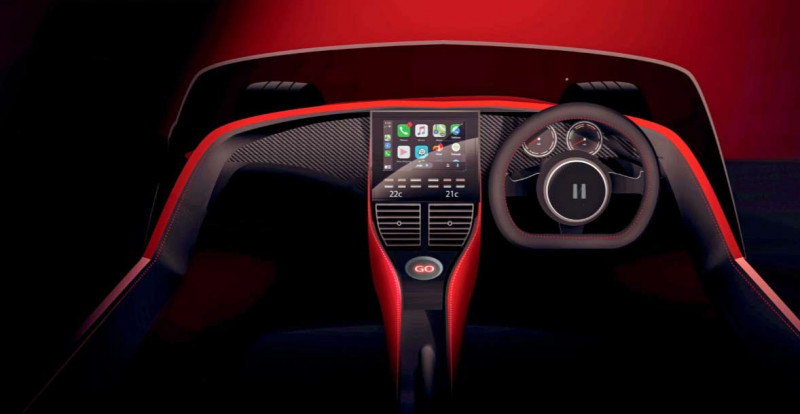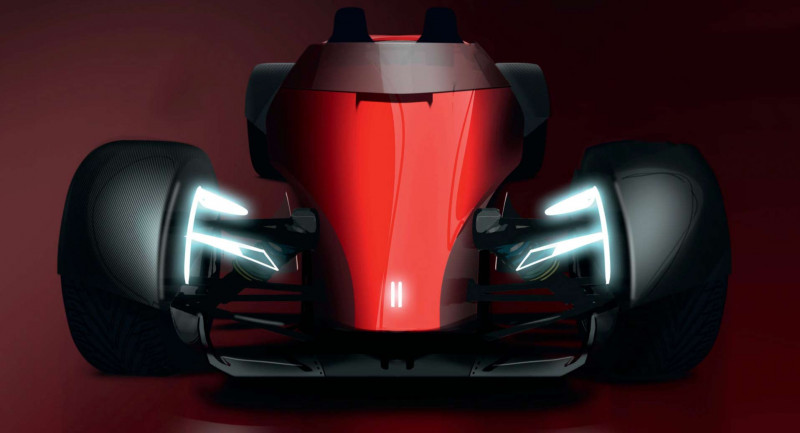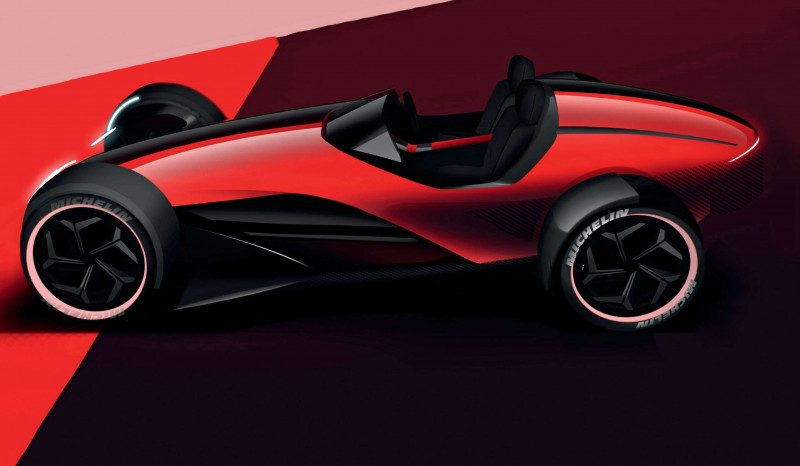EV Clean-sheet two-seater for 2030
How will Britain’s low-volume car makers survive the upcoming ban on new ICE cars? Steve Cropley sits down with Equipmake and WEVC to plan an enthusiast’s electric roadster
DRIVESTODAY CREATES ITS OWN TWO-SEAT EV
Meet the Backfire, a post-2030 niche driver’s car designed to provide a solution for Britain’s low-volume sports car manufacturers – and their customers – when sales of new piston-engined cars are banned come 2030. Until now, our government’s decision to halt petrol and diesel sales in eight years’ time has looked like unbridled bad news for this resilient band of creators, pushing them towards impossible choices. Because most don’t have access to the massive investment funds that the big manufacturers are deploying to create new platforms and adopt new propulsion technologies, many low-volume car makers must contemplate either going out of business or producing compromised versions of existing models.

However, a pioneering agreement between Norfolk-based electric propulsion specialist Equipmake and Cornish engineering company WEVC suggests a way forward. Equipmake designs and makes light and compact electric motors and associated paraphernalia, and it has already demonstrated its diversity by providing EV propulsion for both the forthcoming Ariel Hipercar and a Spanish-built double-decker bus by Beulas, soon to start trials in London.
WEVC recently launched a flexible platform designed especially for low-volume applications, called Paces, which will soon be the basis for an important commercial vehicle deal and is already being used for WEVC’s own light, low-volume electric coupé, which adopts styling from the Porsche 356 and will go on sale during 2022.
The whole powertrain assembly will be similar in size to the differential of an old rear-driven Ford Sierra
When the Equipmake and WEVC co-operation was first announced earlier this year, we instantly wondered what kinds of driver’s car the new link might make possible. It seemed an absolute no-brainer to use the engineering skills of the two companies’ principals, Ian Foley (Equipmake) and Neil Yates (WEVC), to plan a new car, along with those of DrivesToday’s in-house car designer, Ben Summerell-Youde, to show how it could look. It didn’t take long for everyone to unite around the idea of a lightweight electric driver’s car in the mould of a new-age Lotus Seven. Foley is a former Lotus Formula 1 engineer and designer whose favourite car is the ultra-lightweight Lotus Europa; and whose contemporary electric powertrains, although very diverse in size and application, have compactness and lightness as their leading characteristics.
Yates has an extensive history of designing and building winning rally cars, where strength and lightness have equal priority. His forthcoming electric coupé, which offers brisk performance and a range in excess of 150 miles from a modest 40kWh Nissan Leaf battery pack, weighs less than 900kg – an amazingly low figure against mass-market EVs.
Both men believe the field is currently open for a low-volume, driver-focused electric roadster, optimally designed and affordably built. Both regret that in recent years, much emphasis in the electric performance car business has been laid on huge power and performance, inevitably accompanied by correspondingly huge weight.

“We’re seeing cars with 1500 or even 1700 horsepower and 0-60mph acceleration times under two seconds,” says Yates. “In my book, having so much performance isn’t the point: the massive batteries these cars require dominate everything else about them: the weight, the size, the cost. Sure, they can generate amazing cornering forces and their electronics can disguise their mass to a degree. But the natural lightness and agility you take for granted in much simpler cars is lost.”
“I think there’s a serious danger of enthusiast drivers getting tired of all the huge numbers,” says Foley. “I mean, what’s a quick enough 0-60mph time for the road? Surely 4.5sec is enough? The real issue is that electric drive has the potential to remove some of a keen driver’s traditional emotive connection with a car. The successful niche EV needs to replace that. It’s why simplicity, compactness and light weight will become so important.”
DESIGNING THE BACKFIRE
We met to discuss around a big table inside Equipmake’s Norfolk headquarters. The remit was clear: propose an electric car for maximum driving pleasure, broadly obeying the simple, time-honoured Seven rules of simplicity, lightness and small size but with every detail of our new design optimised to meet the challenges of electrification. Why the name? Because a backfire is a reaction to internal combustion in the opposite direction. That seemed appropriate. Naturally, our proposed car is a two-seater.
There’s a serious danger of enthusiast drivers getting tired of all the huge numbers
That format limits its size and bulk, which in turn affects other key stuff, like battery size, brake size and tyre size. And given the wonderful controllability (and slideability) the traditional Seven gets from having rear-wheel drive and locating its driver closer to its rear axle than its front, we decided to opt for that, too. Yates specified that the front-wheel contact patch should be around 75cm ahead of the driver’s feet in the cause of crash safety (we all agreed that the car should meet the relevant modern standards).
The Backfire may have the broad proportions of the Seven, but the requirements of its styling are fairly different. For one thing, it doesn’t need to scoop as much air into a bluff radiator nacelle as the Seven; its much more subtle intakes can be located beneath the car, says Foley. The coming of electrification places more emphasis on sophisticated aerodynamics as a way of preserving range and performance while running the smallest (and therefore lightest) battery practicable, so the Backfire is streamlined and has a small frontal area.
It keeps cycle wings (perhaps more closely wrapped around the wheels than the Seven’s), both for simplicity and as a way of reducing body bulk and weight. We’re looking for zero lift at speed, not downforce, so there are no anti-lift aero bits; they increase drag that cuts range and performance. It’s better to concentrate on making a car with great inherent mechanical grip.
There are no doors: for the Backfire, they’re a needless addition to complexity, weight and cost. The windscreen is simple in design, too. Perhaps not entirely flat, because shaped screens aid cockpit comfort quite a lot and are easier and cheaper to produce for low-volume cars than they were in 1957. But there’s no space or desire for complicated and heavy wind-up windows.
Rather than the Seven’s time-honoured, cumbersome and rarely used pram-hood arrangement, the Backfire has a simpler, collapsible plug-in frame and a canopy that’s made from the high-tech stretch materials now common in camping and sports equipment. It easily rolls into a pack the size of a Coke bottle. In any case, we’re hoping Backfire owners will have the same disdain for hood-up driving as Seven drivers have done for the past 60-odd years.
The chassis is a special version of Yates’s aluminium Paces platform, with the battery carried mostly beneath or forward of the occupants. There’s space in the car’s central spine, too, because this one has a high centre console; Seven-style cars have always benefited from ‘tub’ seating. The suspension is a bespoke all-independent system, as in other Paces applications.
The electric motor, a single 100kW (134bhp) unit, is carried on the rear axle between the rear wheels. Foley reckons the whole powertrain assembly, including the inverter, will be similar in size to the differential of an old rear-driven Ford Sierra. Which is to say there’s very little of it compared with an old-style engine. There are no chassis-balancing electronics, just a plate-style limited-slip diff that tames wheelspin without eliminating it. Being able to powerslide this car with precision will be a large part of its appeal.
The Backfire’s all-up weight is critical to everything: performance, braking, steering, handling and on-the-limit cornering. Yates and Foley reckon that, with a 40kWh Nissan Leaf battery pack, it should weigh around 650kg at the kerb – a clear 150kg more than today’s lightest petrol Caterham Seven but impressive against almost anything else. The car has modest 195-section tyres, uses Ford or similar brakes, has unassisted steering and needs no expensive running gear – although in the way of these things, the aftermarket would probably soon offer pricier add-ons.
Performance? We’re talking sub-5.0sec 0-60mph acceleration and a top speed of around 100mph. Fast motorway cruising will never be the Backfire’s speciality, but with a 40kWh battery, a light weight and a fat low-end torque delivery, it ought to feel entertainingly quick on B-roads and back roads. “You need enough torque to break traction easily and to slide the car on demand,” says Foley. Plus, it will have a better range (up to 200 miles) than most would expect.
What about comfort? People often make the mistake of imagining that it doesn’t matter in cars like these, but in actual fact a sporting driving position can be one of the most inspiring facets of a good car going. The Backfire’s lack of a front-mounted engine and the fact that it has no intrusive gearlever or clutch linkages mean it can have one of the least compromised driving positions around: low, snug, compact and supportive.
True, the Backfire doesn’t have much in the way of plush upholstery (for many an owner, drainage holes in the floor will be more important in bad weather than a canopy), but it does offer ergonomically pure seats, controls and switches. The Backfire uses the driver’s smartphone as the control unit for its audio and navigation functions: its only built-in necessities are simple, digital displays for speed and range. Gear engagement needs nothing more than some kind of on-switch and a simple drive/neutral/reverse control – perhaps a nice-looking lever on the dashboard. What about the price? Foley and Yates reckon that anyone who made a car like this would have to retail it for less than £40,000. If it looked good enough, they believe, it would find keen buyers. It wouldn’t be any use for the track days at which so many petrol Sevens spend their time, because flat-out driving currently expends lithium ion power too quickly for comfort. But by the time we reach 2030, solid-state batteries should be with us, and perhaps even that game will have changed.
THE LOGIC BEHIND THE DESIGN
DrivesToday’s picture editor is a Coventry-trained car designer, Ben Summerell-Youde, and he has created more cars than anyone else we know. You will find his work in practically every issue of DrivesToday.
Much of what he creates is speculative. When he draws something that turns out to be a new BMW, Ferrari or Jaguar, the reaction tends to be familiar: “Well, if it doesn’t turn out like that, it probably ought to.” The idea for the Backfire, the basic electric roadster you see here, came from news of the new business link between electric motor manufacturer Equip-make and engineering firm WEVC, which recently launched a highly flexible platform for low- to medium-volume electric cars.
“The ban on new petrol and diesel cars beyond 2030 could pose problems for the UK’s low-volume car makers,” says Summerell-Youde, “but I reckon it can also promote new opportunities and refresh the whole scene.
“EVs can be built in many configurations. The Backfire puts the battery under the floor and the motor and inverter just behind the occupants, which allows a lot of body design flexibility. The trick, I believe, will be to create modern shapes but avoid doing things that are so radical that they lose a connection with the cars we already know and love. That’s what I’ve tried to do here.”

Cropley and Foley delve into our car’s electric tech
Aero-tuned carbonfibre body parts bolt to aluminium skateboard to smooth airflow past wheels and collect cooling air for the battery, motor and inverter.
High rear body allows teardrop tail for better aero and potential carrying space. Sculpted rollover hoops, rather than a crude roll-cage, protect occupants.
Flat floor has neat venturis incorporated into the rear, but the car’s main aero principle is for nearzero lift and low drag, rather than excessive downforce.
The Backfire uses fairly tall, fairly narrow 195-section eco tyres and tight cycle wings to cut its frontal area and rolling resistance and promote ‘interesting’ handling.
Single-piece body with no doors is supported by a simple aluminium frame. The Backfire’s all-up weight should be about 650kg when it’s ready to go.
Simple step-in cockpit uses your smartphone to provide most driver information; it has ultra-simple controls and digital displays for speed and range.
The ultra-compact headlight and daytime-running light design is enabled by the latest LED technology. Lights follow the lines of the suspension and wheels.
WEVC’s Neil Yates and Equipmake’s Ian Foley lend their expertise
The nose cone is about half the height of a Caterham’s, because a large aperture isn’t needed; cooling air for the powertrain and battery are collected beneath the car. Low screen is enabled by McLaren Elva-style wind deflector. The Backfire can be configured with a variety of screens, including a version that supports a basic stretch-over hood.
Battery is carried on WEVC-designed skateboard chassis beneath body, although high central console also provides space if needed. Lightness and efficient aero give good range.
Equipmake single-speed electric motor is mounted between driven rear wheels. The compact motor and its inverter are about the same size as an old-style differential.
Onepiece painted carbonfibre skin allows considerable design flexibility. Cycle wings emphasise minimal design but will benefit from aero development.


